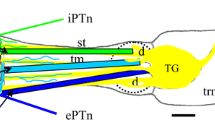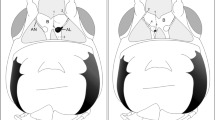Summary
Afferent chemosensory and mechanosensory pathways from peripheral sensory structures (the rhinophore and tentacle) to the cerebropleural ganglion (‘ brain ’) of the molluscPleurobranchaea were investigated using anatomical and electrophysiological methods. In both structures a sensory epithelium is connected by afferent nerves to a peripheral ganglion which sends a nerve (rhinophore or tentacle nerve) to the cerebropleural ganglion.
-
1.
Filling the distal stumps of afferent nerves distal to the rhinophore and tentacle ganglia with cobaltous chloride (centrifugal fills of distal nerves) stained the somata of receptor cells in the sensory epithelium (Fig. 1), suggesting that primary afferent neurons project uninterrupted from the epithelium to the peripheral ganglia.
-
2.
Filling proximal stumps of afferent nerves distal to the rhinophore and tentacle ganglia with cobaltous chloride (centripetal fills of distal nerves) stained mainly fiber tracts that terminated in the peripheral ganglia (Figs. 3, 5) suggesting that primary afferent input is processed mainly in these peripheral ganglia.
-
3.
Filling distal stumps of nerves connecting the peripheral ganglia to the cerebropleural ganglion with cobaltous chloride (centrifugal fills of proximal nerves) stained approximately 100 somata in each peripheral ganglion but stained few axons in distal afferent nerves (Figs. 4, 5), suggesting that the rhinophore and tentacle nerves consist mainly of axons of interneurons arising in peripheral ganglia. Centripetal fills of proximal nerve stumps stained few (10–25) somata in the cerebropleural ganglion.
-
4.
Transganglionic extracellular activity induced by extracellular stimulation of appropriate nerve roots was reversibly reduced in calcium-free sea water, indicating transmission of information across chemical synapses in the peripheral ganglia (Fig. 6).
-
5.
Intracellular recordings were obtained from the somata of 79 interneurons in the tentacle and rhinophore ganglia while delivering sensory stimuli to the corresponding sensory structures. 53 cells showed reliably an action potential response to mechanical and/or chemical stimulation (Figs. 7, 9, 11–13, 15, 16, 18). The majority of cells were bimodal (mechano- and chemosensory), although monomodal (mechanosensory or chemosensory) cells were also encountered. In most cases (47/53) the response was excitatory, but in a few cases (6/53) inhibitory responses were obtained (Fig. 18).
-
6.
Lucifer yellow injections were made for a representative number of such interneurons (Figs. 8, 10, 14, 17). Most of these showed monopolar neurons with a single axon passing from each soma into the rhinophore or tentacle nerve toward the cerebropleural ganglion, although injections of monomodal chemosensory interneurons (n = 2) revealed a bipolar configuration (Fig. 17).
-
7.
The results collectively suggest that chemosensory and mechanosensory inputs from primary epithelial receptor cells of the rhinophore and tentacle are integrated in the peripheral ganglia and relayed to the central nervous system by a population of sensory interneurons.
Similar content being viewed by others
References
Audesirk T (1979) Oral mechanoreceptors inTritonia diomedea I. Electrophysiological properties and location of receptive fields. J Comp Physiol 130:71–78
Audesirk G, Audesirk T (1980a) Complex mechanoreceptors inTritonia diomedea. I. Responses to mechanical and chemical stimuli. J Comp Physiol 141:101–109
Audesirk G, Audesirk T (1980b) Complex mechanoreceptors inTritonia diomedea II. Neuronal correlates of a change in behavioral responsiveness. J Comp Physiol 141:111–122
Bacon JP, Altman JS (1977) A silver intensification method for cobalt-filled neurons in wholemount preparations. Brain Res 138:359–363
Bicker G, Davis WJ, Matera EM, Kovac MP, StormoGipson DJ (1982) Chemoreception and mechanoreception in the gastropod molluscPleurobranchaea california. I. Extracellular analysis of afferent pathways. J Comp Physiol 149:221–234
Bullock TH, Horridge GA (1965) Structure and function in the nervous systems of invertebrates, vol II. Freeman, San Francisco
Byrne J, Castellucci V, Kandel ER (1974) Receptive fields and response properties of mechanoreceptor neurons innervating siphon skin and mantle shelf inAplysia. J Neurophysiol 37:1041–1064
Chase R, Kamil R (1981) Intact and regenerated snail tentacles studied with HRP staining and olfactometry. Soc Neurosci Abstr 7:250
Cobbs J, Pinsker HM (1978)In vivo responses of paired giant mechanoreceptor neurons inAplysia abdominal ganglion. J Neurobiol 9:121–141
Davis WJ, Matera EM (1982) Chemoreception in gastropod mollusks: electron microscopy of putative receptor cells. J Neurobiol 13:79–84
Davis WJ, Villet J, Lee D, Rigler M, Gillette R, Prince E (1980) Selective and differential avoidance learning in the feeding and withdrawal behavior ofPleurobranchaea californica. J Comp Physiol 138:157–165
Fredman SM, Jahan-Parwar B (1975) Synaptic connections in the cerebral ganglion of Aplysia. Brain Res 100:209–214
Garnault P (1887) Recherches anatomiques et histologiques sur leCyclostoma elegans. Act Soc Linn (Bordeaux) 41:11–158
Gelperin A (1975) Rapid food-aversion learning in a terrestrial mollusk. Science 189:567–570
Getting PA (1976) Afferent neurons mediating escape swimming in the marine molluskTritonia. J Comp Physiol 110:271–286
Hanström B (1925) Über die sogenannten Intelligenzsphären des Molluskengehirns und die Innervation des Tentakels vonHelix. Acta Zool (Stockh) 6:183–215
Hanström B (1926) Vergleich zwischen der Innervation der Fühler bei stylommatophoren und basommatophoren Pulmonaten. Zool Anz 66:197–207
Hanström B (1928) Vergleichende Anatomie des Nervensystems der Wirbellosen Tiere. Springer, Berlin
Jahan-Parwar B (1972) Behavioral and electrophysiological studies on chemoreception inAplysia. Am Zool 12:527–537
Jahan-Parwar B, Fredman SM (1976) Cerebral ganglion ofAplysia: Cellular organization and origin of nerves. Comp Biochem Physiol 54:347–357
Jahan-Parwar B, Fredman SM (1978a) Control of pedal and parapodial movements inAplysia. I. Proprioceptive and tactile reflexes. J Neurophysiol 41:600–608
Jahan-Parwar B, Fredman SM (1978b) Control of pedal and parapodial movements inAplysia. II. Cerebral ganglion neurons. J Neurophysiol 43:609–620
Jahan-Parwar B, Fredman SM (1979) Role of interganglionic synaptic connections in the control of pedal and parapodial movements inAplysia. Brain Res Bull 4:408
Kovac MP, Davis WJ (1980) Neural mechanism underlying behavioral choice inPleurobranchaea. J Neurophysiol 43:469–487
Matera EM, Davis WJ (1982) Paddle cilia (discocilia) in chemosensitive structures of the gastropod molluskPleurobranchaea californica. Cell Tissue Res 222:25–40
Mpitsos GJ, Collins SD (1975) Learning: Rapid aversive conditioning in the gastropod molluskPleurobranchaea. Science 188:954–957
Mpitsos GJ, Davis WJ (1973) Learning: Classical and avoidance conditioning in the molluskPleurobranchaea. Science 180:317–320
Mpitsos GJ, Collins SD, McClellan AD (1978) Learning: A model system for physiological studies. Science 199:497–506
Thiele J (1887) Ein neues Sinnesorgan bei Lamellibranchiern. Zool Anz 10:413–414
Tyrer NM, Bell EM (1974) The intensification of cobalt filled neurone profiles using a modification of Timm's sulphidesilver method. Brain Res 73:151–154
Walters ET, Carew TJ, Kandel ER (1979) Classical conditioning inAplysia californica. Proc Natl Acad Sci USA 76:6675–6679
Author information
Authors and Affiliations
Rights and permissions
About this article
Cite this article
Bicker, G., Davis, W.J. & Matera, E.M. Chemoreception and mechanoreception in the gastropod molluscPleurobranchaea californica . J. Comp. Physiol. 149, 235–250 (1982). https://doi.org/10.1007/BF00619217
Accepted:
Issue Date:
DOI: https://doi.org/10.1007/BF00619217




